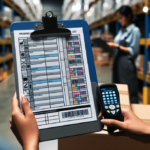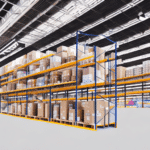Understanding Fulfillment Models
When it comes to order fulfillment for your online business, choosing the right model is crucial for efficiency and customer satisfaction. The two primary options are Direct Fulfillment and Amazon Direct Fulfillment. Each model has its unique advantages and challenges, making it essential to understand them thoroughly before making a decision.
What is Direct Fulfillment?
Direct Fulfillment is a business model where you store and manage your inventory in your own warehouse or storage facility. When a customer places an order on your website, you handle the entire process—from picking and packing to shipping the product directly to the customer's address.
This model offers:
- Full control over inventory management and the fulfillment process
- Customization of packaging and branding
- Potential for faster shipping times, especially for local deliveries
However, it also requires significant investment in warehouse space, equipment, and personnel.
What is Amazon Direct Fulfillment?
Amazon Direct Fulfillment is a service provided by Amazon that allows businesses to utilize Amazon’s extensive network of fulfillment centers. Amazon handles the storage, shipping, and customer service aspects, enabling sellers to focus on other areas of their business.
Key benefits include:
- Access to Amazon’s vast customer base
- Reduced shipping and storage costs through Amazon’s economies of scale
- Integration with Amazon’s marketing and advertising tools
Pros and Cons of Each Fulfillment Model
Advantages of Direct Fulfillment
- Complete control over inventory and fulfillment processes
- Ability to offer personalized packaging and branding
- Potential for lower long-term costs by avoiding third-party fees
- Direct access to customer data for targeted marketing
Advantages of Amazon Direct Fulfillment
- Access to Amazon’s extensive fulfillment network for faster delivery
- Lower shipping fees and discounted rates
- Increased visibility through Amazon’s platform
- 24/7 customer service managed by Amazon
Disadvantages of Direct Fulfillment
- High upfront costs for warehousing and staffing
- Responsibility for managing inventory and handling logistics
- Limited access to a broader customer base compared to Amazon
- Challenges in scaling operations efficiently
Disadvantages of Amazon Direct Fulfillment
- Additional fees associated with using Amazon’s services
- Potentially higher commission rates on sales
- Less control over pricing and customer interactions
- Complexity in managing inventory within Amazon’s system
Cost Analysis
Cost is a critical factor when choosing between Direct Fulfillment and Amazon Direct Fulfillment. Direct Fulfillment may involve higher initial investments in warehousing, technology, and labor. However, it can offer lower long-term costs by eliminating third-party fees and commissions.
In contrast, Amazon Direct Fulfillment operates on a fee-per-service model, which can be more cost-effective for smaller businesses or those with lower sales volumes. According to a Shopify report, leveraging Amazon’s infrastructure can reduce shipping costs by up to 30% for certain businesses.
Customer Experience and Service
The fulfillment model you choose significantly impacts the customer experience. Direct Fulfillment allows for a personalized touch, from custom packaging to direct interaction with customers, fostering brand loyalty.
Amazon Direct Fulfillment, on the other hand, benefits from Amazon’s reputation for reliability and swift delivery, which can enhance customer trust and satisfaction. However, it limits your ability to interact directly with customers, as Amazon handles all customer service inquiries.
Logistics: Shipping, Delivery, and Inventory Management
Shipping and Delivery
Direct Fulfillment can offer faster local shipping options, giving you the flexibility to choose carriers and shipping methods that best suit your business needs. Amazon’s vast network ensures quick and reliable delivery times globally, benefiting from their optimized logistics infrastructure.
Inventory Management
Managing inventory in Direct Fulfillment requires robust systems to track stock levels, manage reordering, and prevent overstocking. Implementing an efficient inventory management system is essential to avoid stockouts and excess inventory.
Amazon Direct Fulfillment provides advanced inventory management tools that automate tracking and alerts, reducing the administrative burden and minimizing human error.
Integration with E-commerce Platforms
Integrating your fulfillment operations with your e-commerce platform is vital for a seamless workflow. Direct Fulfillment offers greater flexibility in customization but may require more complex integrations and investments in technology.
Amazon Direct Fulfillment seamlessly integrates with the Amazon Marketplace and tools like Amazon Seller Central, simplifying the management of your business operations and inventory synchronization.
Choosing the Right Option for Your Business
The decision between Direct Fulfillment and Amazon Direct Fulfillment hinges on your specific business needs, goals, and resources. Consider the following factors:
- Control vs. Convenience: Direct Fulfillment offers more control, while Amazon provides convenience and reach.
- Budget: Assess your capacity for upfront investment versus ongoing service fees.
- Customer Base: Determine whether access to Amazon’s vast marketplace aligns with your target audience.
- Scalability: Consider how each model supports your business growth plans.
Conclusion: Making the Right Choice for Your Business
There is no one-size-fits-all solution for order fulfillment. Both Direct Fulfillment and Amazon Direct Fulfillment offer unique benefits and challenges. By analyzing your business needs, evaluating the costs and advantages, and considering the impact on customer experience and operations, you can make an informed decision that aligns with your growth and success objectives.






















